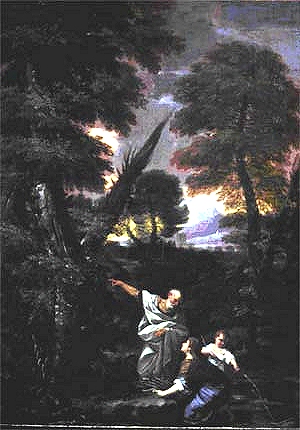 |
|
The Prophet Elijah and the Widow of Zarephath
Pier Francesco Mola, Italian 1612-1666
SN 138. Oil on Canvas 1648/50
by Robert Anderson.
Artist:
Pier Francesco Mola was an Italian baroque painter who was active primarily in Rome. His
style was characterized by warm coloring and soft modelling, and was formed mainly on the
example of Guercino and the Venetian artists. His most characteristic works are fairly
small canvases with religious or mythological figures set in landscapes.
Mola finished his training in northern Italy and launched his career 1640.
His frescoes at this time showed him to be a slow learner who lacked confidence in
creating multi-figured dramatic compositions. Subsequent study in Venice and Bologna
accounted for an increasingly Venetian influence which can be seen in a number of small
cabinet paintings in which the landscape dominates the figures. These landscapes are
strongly Venetian, and their idyllic mood suggests the influence of Francesco Albani who
wrote of Mola having studied with him. |
Among these paintings are the pendants of the Prophet Elijah and the
Rich Woman of Shunem and the Prophet Elisha and the Widow of Zarephath.
Subject:
The prophet Elijah was a religious leader of the Israelites. During a time of famine he
was directed, by God, to go to the town of Zarephath to find food. When he arrived he
asked a widow woman for food and water. She gave him what she believed to be the last of
her food. Elijah then saw to it, with God's help, that she and her family never wanted for
food but were fed miraculously from a barrel of meal which never emptied and a flask of
oil which was always full.
Painting:
The painting shows the Prophet Elijah seated within a a landscape, beside a brook. As the
widow of Zarephath approaches with her son, Elijah is seen holding out his hand - asking
for bread and water. He is an older man with a beard and balding head and is dressed in a
dark shirt with a white outer robe which is highlighted.
The landscape is dark and the evening sky is cloudy with just a few rays
of sun breaking thru. The painting is typical of Mola's paintings in which the landscape
dominates the scene and almost overwhelms the figures which appear almost secondary in
importance.
Historical Context:
Both this painting and its companion, the Prophet Elisha and the Rich Woman of Shunem, are
closely related to the Carmelite Order. The prophet Elijah is considered the founder of
the order since he had lived as a hermit on Mount Carmel. Elisha was included in the
Carmelite dynasty of ideal role models.
It is believed that the two paintings were commissioned for the church of
St. Martino ai Monti in Milan since their subjects were relevant to 18 frescoes at that
location, 12 of which depict scenes from the lives of Elijah and Elisha.
|
